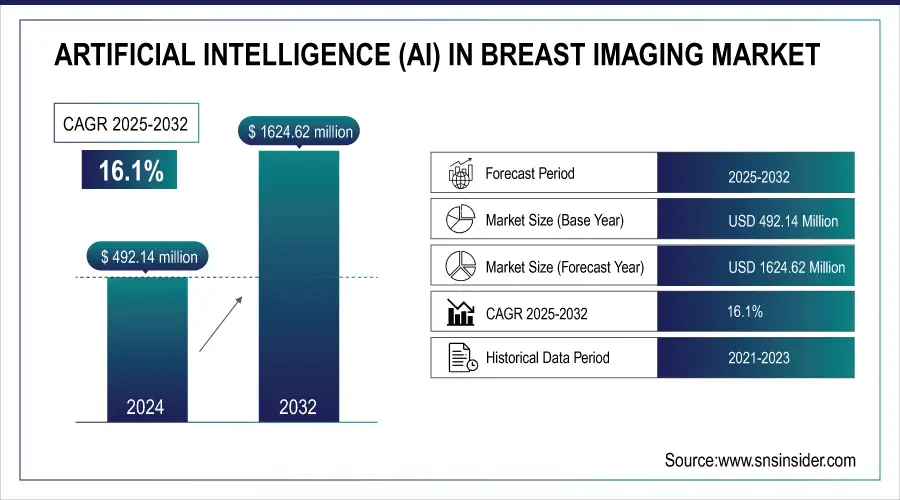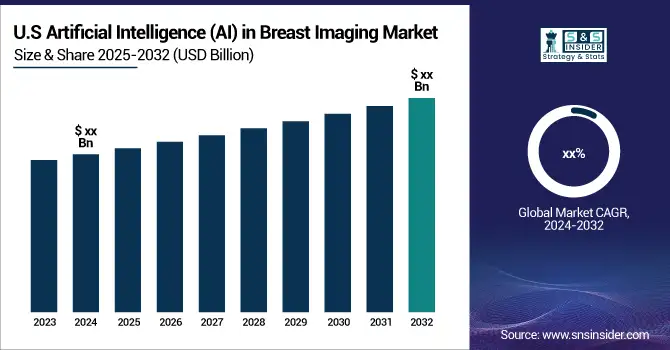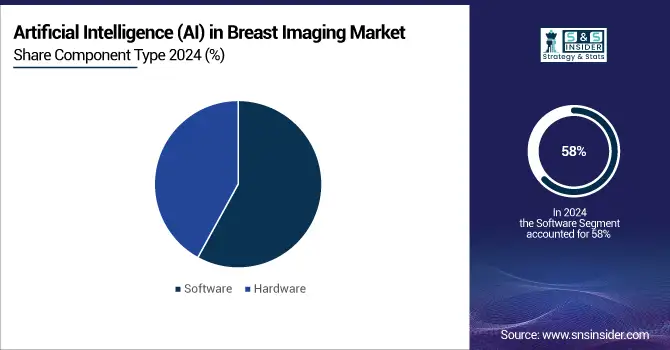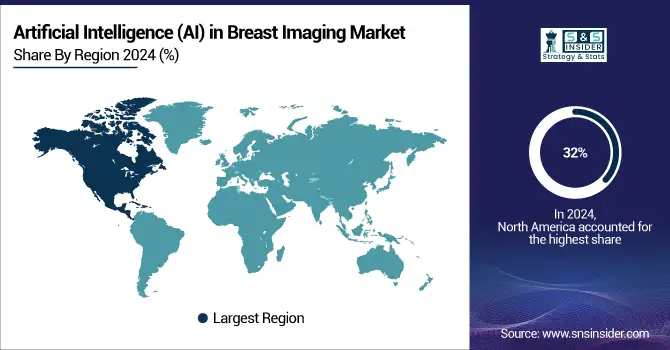Artificial Intelligence (AI) in Breast Imaging Market Report Scope & Overview:
The Artificial Intelligence (AI) in Breast Imaging Market Size was valued at USD 492.14 million in 2024 and is expected to reach USD 1624.62 million by 2032 and grow at a CAGR of 16.1% over the forecast period 2025-2032.

Get More Information on Artificial Intelligence (AI) in Breast Imaging Market - Request Sample Report
AI in Breast Imaging Market Growth and Impact
-
AI reduces radiologists’ workload and false positives, with studies showing a 20% drop in recall rates and a 33% decrease in reading workload.
-
Deep learning and machine learning improve screening, diagnosis, disease monitoring, and data management in breast imaging.
-
Rising breast cancer prevalence, with 684,996 deaths globally in 2020 and 297,790 new U.S. cases projected in 2023, is driving AI adoption.
-
AI systems offer higher accuracy, reduce false positives, and support early detection compared to traditional imaging methods.
-
Growing demand for AI-powered solutions is expanding the global breast imaging market, particularly in early diagnosis and personalized care.
The major factor contributing to the increasing demand of advanced artificial intelligence technology on breast imaging is the significant rise in the cancer cases worldwide, particularly breast cancer. WHO also reports that breast cancer is first in the list of types of cancer in women worldwide. It has thus become a relative public health concern. The rate of breast cancer varies greatly on the geographical location and is influenced by factors such as age, genetics, hormonal changes and lifestyle. The American Cancer Society projects that there will be approximately 297,790 new invasive cases and about 55,720 new DCIS rates in the United States for the year 2023. Unfortunately, they estimate that around 43,700 women will die of breast cancer this year. The increase in the numbers of breast cancer cases has thus necessitated accurate screening and diagnostic measures. The AI technology has since gained more relativity and placed more importance in the area as it offers better accuracy especially during early diagnoses and screening, which is a better need due to increased number of cases. The AI systems are programmed with highly sophisticated deep learning and machine learning algorithms that enable accurate analysis of mammographic images, which increase the detection rates and significantly reduce the number of false positives. False positive is a vital factor as it aids in handling the large number of patients as well as dealing with the limitation presented by the traditional imaging modalities. This is further facilitated by the fact that the number of breast cancer cases continue to rise across the globe will necessitate increased demand of AI breast imaging solutions hence force further development and expansion of the market.

Artificial Intelligence (AI) in Breast Imaging Market Drivers
-
An important factor for the utilization of AI in breast imaging.
The increasing number of mammograms and lack of specialists in breast imaging are major reasons why Artificial Intelligence (AI) is being used more in this field. Breast cancer screening for the general population, while successful in lowering death rates, creates a significant workload for radiologists who have to examine many mammograms, most of which show no signs of abnormal growths. This task becomes more difficult with methods such as double reading, designed to improve cancer identification and decrease unnecessary follow-ups, leading to increased work levels. A recent study showed that incorporating AI systems could ease these pressures without compromising screening performance. The AI system used in a Danish mammography screening program has the potential to decrease radiologists’ workload by enabling them to do single readings on mammograms that the AI deems as probably normal. This could maintain sensitivity, enhance specificity, and lower the number of false-positive recalls. The AI system’s capacity to identify and evaluate suspicious lesions and generate a grade that categorizes the likelihood of breast cancer is very important. This AI-powered method not just simplifies the screening process but also aids radiologists in handling their workload more efficiently. Showcasing the need for AI tools that improve efficiency and diagnostic precision in response to rising demands on healthcare workers using technology. The crucial factor driving market growth and adoption in breast imaging is the potential for AI to help radiologists in managing their workload and improving diagnostic performance.
- Advancements in artificial intelligence technology are speeding up the progress of breast imaging evolution.
Progress in Artificial Intelligence (AI) technology, specifically with deep learning algorithms and machine learning models, is greatly pushing forward the development of breast imaging solutions. These advanced AI technologies improve the accuracy and efficiency of breast cancer screening by allowing for more precise analysis of mammographic data. Deep learning algorithms have the ability to analyze large amounts of imaging data, detecting subtle patterns and anomalies that human radiologists might overlook. This results in more precise and timely detection of breast cancer. Machine learning models enhance this process by acquiring knowledge from extensive data sets, continuously enhancing their capability to forecast and diagnose more accurately. Incorporating advanced AI technologies into breast imaging systems enhances diagnostic results and tackles issues like false positives and missed detections in traditional mammography. The accuracy of AI diagnostic tools is increasing its use in healthcare to enhance patient outcomes and streamline screening processes. This advancement in technology is a key factor in the market, highlighting the increasing need for advanced AI solutions in breast imaging that offer improved accuracy in diagnosis, efficiency, and ultimately, better handling of breast cancer.
Artificial Intelligence (AI) in Breast Imaging Market Restraints
-
Challenges in Adoption and Integration Limit AI’s Growth in Breast Imaging Market
The breast imaging AI market is highly promising and may expand in the future. However, it is characterized by several important limitations that prevent its widespread acceptance and integration. Firstly, advanced AI systems are difficult to implement due to the high cost of using them. For this reason, many healthcare facilities, especially with limited budgets, may experience obstacles in directing investments in advanced AI algorithms and the necessary technology and equipment. Secondly, integrating AI into existing imaging processes can be challenging and time-consuming, as radiologists and technicians need to be thoroughly educated to use the data that AI provides effectively. Thirdly, it is difficult to obtain regulatory approval and verify with clinical trials. Description, using AI and the systems available, perform data in a safe and contextually appropriate way, and the solutions need to be rigorously validated and approved by regulators before they are widely adopted. The approval process usually takes a long time and can be expensive, which may delay the launch of the next generation of AI solutions in the foreseeable future market. Fourthly, further concern is data security because AI systems rely on data shearing and processing. To ensure confidentiality and protection of patient data, as well as to meet stringent data protection laws, is an extraordinary additional challenge.
Artificial Intelligence in Breast Imaging Market Segment Analysis
-
Based on Component Type, Software is dominated in Artificial Intelligence (AI) in the Breast Imaging Market with 58% of share in 2024
The increasing use of advanced AI algorithms and software solutions is driving this dominance in improving breast imaging processes. AI software used in breast imaging consists of sophisticated deep learning models and machine learning algorithms that examine mammographic images, detect irregularities, and support radiologists in achieving more precise diagnoses. The software's crucial role in enhancing screening accuracy and minimizing false positives and negatives lies in its capacity to efficiently handle large volumes of imaging data with great accuracy. For example, Siemens Healthineers and Hologic are leading the way in innovation in this industry. Siemens Healthineers has created imaging solutions that use AI technology and work smoothly alongside their mammography systems, providing functions such as automated lesion detection and tools for assessing risk. Hologic's 3D Mammography system, incorporating AI algorithms, enhances breast cancer screenings with improved image quality and diagnostic accuracy through the use of AI technology. These new developments demonstrate the increasing popularity of incorporating AI technology in breast imaging to optimize processes, boost diagnostic precision, and enhance patient results. The important portion of AI software in the market highlights its crucial contribution to advancing breast imaging technologies, promoting the further growth and use of AI-based solutions in the healthcare industry. With the ongoing advancement of AI technology, the need for more advanced software solutions in the AI in breast imaging market is predicted to grow, further establishing its dominance in the field.

-
Based on Imaging Modality, Screening is captured in Artificial Intelligence (AI) in the Breast Imaging Market with 42% of share in 2024
The rise in importance is due to the growing focus on early detection and preventive care in managing breast cancer. AI-powered screening solutions play a crucial role in improving mammography procedures by enhancing image evaluation, identifying irregularities, and decreasing instances of incorrect results. Google Health and iCAD are at the forefront of advancements in this sector. Google Health, working alongside different healthcare facilities, has created AI algorithms that greatly improve the accuracy of mammogram interpretations. Their AI models have proven to be more accurate than traditional methods, decreasing errors and improving cancer detection. iCAD has also launched the ProFound AI platform, which incorporates cutting-edge deep learning algorithms to help radiologists identify and analyze breast lesions. The ProFound AI system accurately examines mammograms, giving radiologists thorough risk evaluations and pinpointing areas of concern for additional examination. This advancement enhances mammography accuracy and simplifies the diagnostic process, aligning with the main objective of screening: early detection. The significant presence of screening in the AI breast imaging market underscores its crucial importance in cancer prevention and the continuous progress in AI technology that is improving early detection abilities. With the increasing need for better screening solutions, the market's growth is driven by the continued use of AI to enhance these processes and enhance patient results.
AI in Breast Imaging Market Regional Analysis
-
North America is dominated in Artificial Intelligence (AI) in the Breast Imaging Market with 32% of share in 2024
This leadership demonstrates the region's sophisticated healthcare system, strong embrace of innovative technologies, and substantial commitment to AI research and development. Key players in North America, like Siemens Healthineers, Hologic, and GE Healthcare, are leading the way in driving advancements within this industry. Siemens Healthineers has achieved significant progress with its AI-Rad Companion Mammography tool, utilizing artificial intelligence to aid radiologists in identifying breast cancer through improved image analysis and automated reporting. This product showcases how AI is utilized to enhance accuracy and efficiency in mammography screenings.

Get Customized Report as per Your Business Requirement - Enquiry Now
Another important player in the industry, Hologic, has introduced the Genius AI platform, a sophisticated AI-powered tool created to enhance their 3D mammography machines. The Genius AI platform improves the accuracy of identifying breast cancer by providing immediate analysis of mammographic pictures, emphasizing suspicious areas, and minimizing incorrect detections. This advancement highlights Hologic's dedication to enhancing screening results and patient care with AI technology.GE Healthcare has also played a role in this expansion by integrating its Deep Learning AI technology into its mammography machines. Their AI technology helps detect slight abnormalities that could be overlooked by conventional methods, thereby enhancing the sensitivity and specificity of breast imaging. The progress in AI-powered breast imaging technology is strengthening North America's position in the worldwide market, thanks to technological innovation, significant healthcare investments, and a commitment to improving early detection and accuracy in breast cancer care. The continuous growth and acceptance of AI solutions in breast imaging practices and patient outcomes are showcased by the region's significant market presence.
-
Asia Pacific is the second fastest region in Artificial Intelligence (AI) in the Breast Imaging Market with 29% of share in 2024
Driven by a mix of growing healthcare funding, enhancing healthcare facilities, and increasing awareness of breast cancer. Countries in the area are progressively utilizing sophisticated technologies to improve diagnostic capabilities and enhance patient outcomes. Canon Medical Systems, Fujifilm, and Samsung Medison are the main contributors to this increase in growth. Canon Medical Systems has launched VitalEye, an imaging solution that utilizes AI and deep learning to help radiologists detect and diagnose breast abnormalities. This system improves mammographic analysis with high-resolution imaging and detailed lesion description, leading to early detection enhancement and decreased diagnostic errors. Canon's inventive approach demonstrates the increasing focus on incorporating AI to improve the accuracy of breast cancer screenings in the area. Fujifilm has made great progress with its AI-powered Breast Imaging Solution, incorporating advanced machine learning models to analyze mammograms and help detect possible abnormalities. The solution includes tools for automated image analysis, risk stratification, and enhanced diagnostic accuracy, leading to more successful and efficient breast cancer screening practices in Asia Pacific. Samsung Medison introduced the UGEO PT60A with advanced imaging features driven by artificial intelligence, improving diagnostic tools with in-depth image interpretation and immediate response for radiologists. This technology aids in better early detection of breast cancer and is in line with the region's growing emphasis on using AI to tackle healthcare issues. The region's dedication to implementing advanced technologies and enhancing breast cancer care is highlighted by the impressive progress and fast expansion of AI in breast imaging in Asia Pacific. The growing market presence demonstrates the region's growing significance in the global AI breast imaging market, propelled by advancements in technology and a commitment to improving diagnostic precision and healthcare results.
Artificial Intelligence in Breast Imaging Market Key Players
The Major players are
-
Gamma Medica, Inc.
-
Siemens Healthcare
-
Fujifilm Holdings Corp.
-
Toshiba Corporation
-
Aurora Imaging Technology Inc.
-
Philips Healthcare
-
iCAD Inc.
-
QuantX Imaging
-
AstraZeneca
-
Sanofi & Others Players
Artificial Intelligence in Breast Imaging Market Competitive Landscape:
Siemens Healthineers
Siemens Healthineers, headquartered in Erlangen, Germany, traces its roots back to 1847 as Siemens & Halske and became a standalone healthcare entity in 2017. A global leader in medical imaging and diagnostics, the company plays a pivotal role in the AI in breast imaging market. Its flagship innovation, the AI-Rad Companion Mammography tool, leverages artificial intelligence to improve image analysis, automate reporting, and enhance early detection accuracy for breast cancer. Backed by significant R&D investments and a strong international presence, Siemens Healthineers continues to drive digital transformation in healthcare, strengthening its leadership in AI-powered breast imaging solutions.
-
In September 2023, Siemens presented the Mammomat B Brilliant system, which utilizes wide-angle tomosynthesis with a 50-degree angle to provide faster 3D imaging in approximately five seconds, effectively detecting abnormalities and microcalcifications with great precision.
Hologic
Hologic, headquartered in Marlborough, Massachusetts, USA, was founded in 1985 and is a global leader in women’s health technologies. The company is at the forefront of the AI in breast imaging market with its Genius AI platform, designed to enhance the performance of its 3D mammography systems. This AI-powered solution improves cancer detection accuracy, highlights suspicious areas, and reduces false positives, thereby supporting radiologists in delivering better patient outcomes. Hologic’s continued focus on innovation in breast imaging and early detection reinforces its strong market position worldwide.
-
In September 2023, Hologic and Bayer formed a collaboration for Comprehensive Contrast-Enhanced Mammography. This Collaboration aims to provide an extensive package of contrast-enhanced mammography, improving the capabilities of breast imaging facilities.
CureMetrix, Inc
CureMetrix, Inc., headquartered in La Jolla, California, USA, is a health-tech company specializing in artificial intelligence solutions for medical imaging. Founded in 2014, the company is a recognized innovator in the AI in breast imaging market with its cmTriage™ and cmAssist® solutions. These FDA-cleared AI-based tools help radiologists by improving the accuracy of mammogram readings, reducing false positives, and enabling earlier breast cancer detection. CureMetrix leverages advanced machine learning and deep learning algorithms to streamline workflow, enhance diagnostic confidence, and support better patient outcomes, positioning itself as a disruptive player in AI-powered breast imaging technologies.
-
In November 2021, CureMetrix, Inc., a leading provider of AI-powered breast imaging solutions, announced the launch of its new product, cmAssist. The product is designed to help radiologists quickly and accurately identify suspicious areas in breast images and is expected to improve the efficiency of breast cancer screening and diagnosis.
Google Health
Google Health, headquartered in Mountain View, California, USA, is a division of Alphabet Inc. dedicated to advancing healthcare through artificial intelligence, data science, and cloud technology. Established in 2018 as a renewed initiative, Google Health has made significant progress in the AI in breast imaging market through collaborations and research projects. Its AI models for mammography have demonstrated performance on par with or exceeding radiologists in detecting breast cancer, reducing false positives, and enhancing early diagnosis. By leveraging deep learning and Google Cloud’s infrastructure, Google Health aims to integrate AI-driven breast imaging solutions into clinical workflows, supporting global efforts to improve cancer detection accuracy and patient care.
-
In September 2021, Google Health announced the launch of its AI-powered mammography tool, which is designed to help radiologists detect breast cancer earlier and more accurately. The tool uses AI algorithms to analyze mammograms and highlight areas that may be indicative of breast cancer.
| Report Attributes | Details |
|---|---|
| Market Size in 2023 | USD 492.14 million |
| Market Size by 2032 | USD 1624.62 million |
| CAGR | CAGR of 16.1 % From 2025 to 2032 |
| Base Year | 2024 |
| Forecast Period | 2025-2032 |
| Historical Data | 2021-2023 |
| Report Scope & Coverage | Market Size, Segments Analysis, Competitive Landscape, Regional Analysis, DROC & SWOT Analysis, Forecast Outlook |
| Key Segments | • By Component Type(Hardware, Software) • By Imaging Modality(Mammography, Ultrasound Imaging, MRI) • By Application(Screening,Diagnostics,Image-guided Biopsy) • By End User(Hospitals and Clinics, Diagnostic Imaging Centers, Research Institutes) |
| Regional Analysis/Coverage | North America (US, Canada, Mexico), Europe (Eastern Europe [Poland, Romania, Hungary, Turkey, Rest of Eastern Europe] Western Europe] Germany, France, UK, Italy, Spain, Netherlands, Switzerland, Austria, Rest of Western Europe]), Asia-Pacific (China, India, Japan, South Korea, Vietnam, Singapore, Australia, Rest of Asia-Pacific), Middle East & Africa (Middle East [UAE, Egypt, Saudi Arabia, Qatar, Rest of Middle East], Africa [Nigeria, South Africa, Rest of Africa], Latin America (Brazil, Argentina, Colombia, Rest of Latin America) |
| Company Profiles | GE Healthcare, Hologic, Inc., Gamma Medica, Inc., Siemens Healthcare, Fujifilm Holdings Corp., Toshiba Corporation, Aurora Imaging Technology, Inc.,Philips Healthcare ,iCAD Inc., QuantX Imaging, AstraZeneca, Sanofi & Others |
| Key Drivers | • An important factor for the utilization of AI in breast imaging. • Advancements in artificial intelligence technology are speeding up the progress of breast imaging evolution. |
| RESTRAINTS | • Challenges in Adoption and Integration Limit AI’s Growth in Breast Imaging Market |

